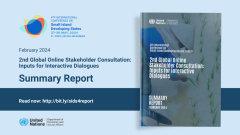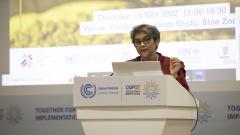- عربي
- 中文
- English
- Français
- Русский
- Español
Remarks at the Thematic Forum on Policy Connectivity of the 2nd Belt and Road Forum
Remarks by Ms. Fekitamoeloa Katoa ‘Utoikamanu, High Representative for the Least Developed Countries, Landlocked Developing Countries and Small Island Developing States
25 April 2019
Beijing, China
Excellencies,
Distinguished delegates,
Ladies and gentlemen,
I am pleased to join you at this forum on an important issue - policy connectivity. Indeed, it must be our shared priority to strengthen links between the goals of Agenda 2030 and the aims of the Belt and Road Initiative (BRI). This is not an abstract exercise - it is about the challenge to deliver tangible and sustainable benefits to the least developed countries (LDCs), landlocked developing countries (LLDCs) and small island developing states (SIDS). The 91 vulnerable countries OHRLLS is a voice that accounts for almost half of the Member States of the United Nations and over 1.1 billion people!
The least developed countries are home to the poorest and weakest segment of the international community. In short, the people most at risk of being left behind! Landlocked developing countries are challenged by their lack of direct access to the sea, remoteness and isolation from world markets. Small island developing States are a “special case” for sustainable development. They are extremely vulnerable to climate change and its economic and social consequences. The 2030 Agenda makes the promise of leaving no-one behind. The Sustainable development goals are our shared global effort to address poverty, reduce inequality and build a future of inclusive and sustainable prosperity for ALL.
The year 2030 is not far away, and it already is clear that the 91 countries need speedy and enhanced support from the global community to transform commitment into impact for people and accelerate their progress towards achieving the goals and targets of their respective programmes of action. The Belt and Road Initiative (BRI) has the potential to support countries' inclusive growth and sustainable development paths. The “five connectivities” of the BRI dovetail with priority areas such as infrastructure development, trade, development finance and human capital development.
The challenge at hand is how countries, in a sustainable way, can leverage resources, expertise and technology that the Belt and Road Initiative intends to transfer. How can we create the capacity and momentum for countries to integrate regional and global value chains, achieve structural transformation and eradicate extreme poverty? Allow me to make a few suggestions: First, quality infrastructure development under the BRI should gear towards LDCs, LLDCs and SIDS to help them overcome the crippling constraints for development posed by the often inadequate and poor state of basic infrastructure.
LDCs, LLDCs and SIDS need resilient and sustainable infrastructure, including infrastructure for energy, transport and ICT to achieve sustainable development. The need for financing for infrastructure development is huge and urgent and we also must be mindful of not creating new debt traps. Infrastructure connectivity proposed by the Belt and Road has potential in assisting their integration into regional and global markets and enabling them to participate in the benefits of globalization. Second, the BRI should be leveraged for LDCs, LLDCs and SIDS to take advantage of modern technologies, especially green technologies, that are needed for adaptation and resilience building. LDCs, LLDCs and SIDS face extreme vulnerability to external shocks including the impacts of climate change.
The recent catastrophic impact of Cyclone Idai is a case in point. The vulnerable countries can leverage the resources, technologies and best practices of China and other participating countries of the BRI to build resilient economies. Third, the BRI should contribute to the integration of LDCs, LLDCs and SIDS into regional and global value chains by enhancing market access, promoting cross-border trade and improving competitiveness. China has become the largest trading partner of LDCs with a share of 33% in LDC exports. The country also is the dominant foreign investor with a stock of USD 34 billion in 2016, representing 11% of total FDI of USD 312 billion.
The BRI and participating countries ought to help open up new markets for LDCs, LLDCs and SIDS while investments in sustainable and improved infrastructure ought to enhance competitiveness and inflow of foreign investment. Excellencies, The BRI expressed goal is inclusive development, shared benefits and practical cooperation. Two years have passed since the 1 st Belt and Road Forum.
Tangible benefits start to emerge on the ground through better infrastructure, increased investment, trade, and people-to-people exchange to name a few. The clock is ticking on the 2030 Agenda. Time is of the essence. We must achieve the sustainable development goals - it is now that we must accelerate actions and renew our commitment to leave no one behind and reach those left furthest behind first. I wish you a fruitful deliberation. I thank you.





